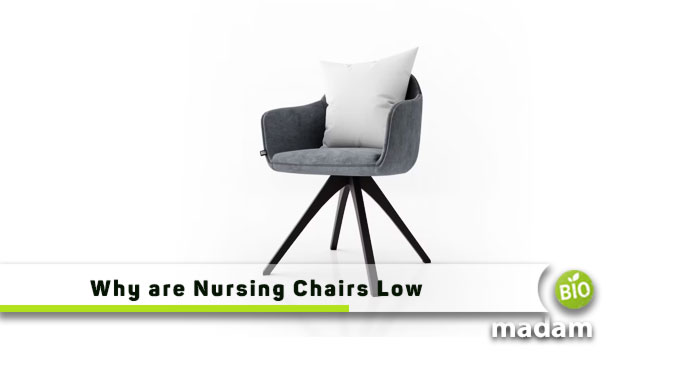When it comes to caring for a newborn, comfort and functionality are of paramount importance, especially for breastfeeding mothers. This is where nursing chairs, specifically designed for this purpose, come into play. These specialized chairs have a distinct feature that sets them apart from regular chairs – they are low in height. But why is this particular design feature so prevalent in nursing chairs, and what makes them different? Let’s explore the world of nursing chairs and discover the thoughtful reasons behind their unique design.
What are Nursing Chairs?
Nursing chairs are more than just regular pieces of furniture. They are carefully crafted to meet the specific needs of breastfeeding mothers and their babies. The primary goal of a nursing chair is to create a comfortable and conducive environment for the essential bonding between a mother and her baby during nursing sessions. The low height of these chairs plays a crucial role in achieving this objective, as we’ll explore further.
History of Nursing Chairs: An Evolution of Comfort
The concept of nursing chairs dates back to centuries ago. These chairs have a rich history, evolving in design and purpose over time. Initially, nursing chairs were simple wooden or upholstered chairs with a low, inviting profile. They were meant to provide a cozy space for mothers to nurse their babies in private, often featuring padded armrests for added comfort. This historical context shows that the idea of low nursing chairs has stood the test of time due to their effectiveness in providing a nurturing environment.
Exploring the Benefits of Low Nursing Chairs

Ergonomics and Comfort
Ergonomic principles in furniture design prioritize the comfort and well-being of users. Low nursing chairs promote proper posture during breastfeeding, benefiting both the mother and the baby. The comfortable seating position is essential for extended nursing sessions, preventing discomfort or strain on the mother’s body.
Accessibility and Ease of Use
For mothers recovering from childbirth, ease of access is crucial. Lower nursing chairs provide a convenient height for getting in and out of the chair, especially when dealing with postpartum fatigue or weakened physical conditions. Additionally, these chairs are designed to accommodate various body sizes and mobility levels, ensuring that every nursing mother can use them comfortably.
Bonding and Eye Contact
Breastfeeding is not just about nourishment; it’s a bonding experience between mother and baby. Maintaining eye contact during nursing is essential for emotional connection and communication. Lower chairs enable better eye-level contact between the mother and the baby, enhancing the bonding experience during this intimate moment.
Privacy and Discretion
Privacy is a significant concern for nursing mothers, especially in public spaces. Lower nursing chairs offer a more discreet nursing experience, as their lower profile provides increased privacy. Additionally, the cozy and enclosed environment created by these chairs ensures that mothers feel comfortable and secure while breastfeeding.
Adaptability and Multi-Functionality
Nursing chairs aren’t limited to the breastfeeding stage alone. They can be used for various purposes beyond nursing, such as soothing fussy babies. The versatility of nursing chairs makes them a valuable investment, serving multiple functions as the baby grows.
What Makes a Nursing Chair Different?
Nursing chairs are more than just ordinary pieces of furniture; they’re designed with the specific needs of breastfeeding mothers in mind. Let’s delve into what sets these chairs apart:

- Thoughtful Design Elements: Nursing chairs feature carefully crafted design elements that cater directly to the needs of nursing mothers. Supportive cushions ensure a comfortable and nurturing experience for both mother and baby. Padded armrests provide extra comfort during breastfeeding sessions, and the gentle recline of the chair is carefully designed to enhance ergonomic support for mothers.
- Comfort and Accessibility: At the heart of nursing chair design is the focus on providing comfort for both the mother and the baby. The low height of nursing chairs ensures easy accessibility, particularly beneficial for postpartum mothers or those recovering from childbirth. This feature makes getting in and out of the chair effortless, reducing strain and enabling mothers to fully engage in these precious bonding moments.
Conclusion
In conclusion, nursing chairs with their low height serve as a vital tool in creating a comfortable, nurturing environment for nursing mothers and their babies. By considering ergonomic principles, accessibility, bonding, and privacy, these chairs enhance the breastfeeding experience, contributing to the well-being of both mother and child. Make sure to always keep your chair clean and maintain it to ease yourself and your baby! When choosing a nursing chair, it’s crucial to prioritize these factors to ensure a positive and enjoyable nursing journey.

People call me Domonique Smith in Ross! I was always fond of helping people, so opted an MBBS degree to pursue my passion as my career. My major interests fall in dealing with pregnant ladies and helping them in the best of my wills for their comfort. I am further planning to choose Gynecology as my major, so wish me luck!

